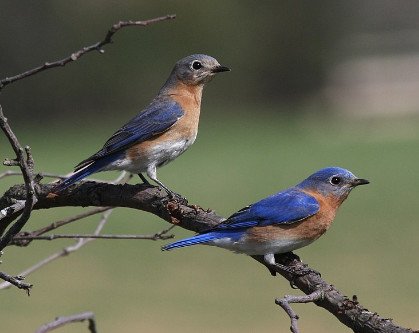15 Types of Bird That Lays Blue Eggs
When one goes birdwatching, they may stumble upon a few nests with bird’s eggs. Some eggs may be brown or white, like the chicken’s eggs. There are a few birds that lay black eggs as well. People can find these to be some of the most common colours of eggs in the bird kingdom.
However, in rare instances, one might marvel at the unique blue-coloured eggs. Astonishing to look at, the blue shades will mesmerize anyone who sees them. Why are these coloured as such? and what are the birds that lay blue eggs?
Let’s find out!
Difference between blue-coloured eggs vs. others
The colour of a bird’s eggshell is formed because of biliverdin (Mayntz). It is a bile pigment that is present in the shell’s gland. Once a bird is about to lay eggs, the pigments slowly move into the shell.
The colour is determined based on the concentration of biliverdin. Smaller eggs have a higher concentration than bigger eggs.
The shades in the pigment can be very bright colours, blue or green. Selected breeds of birds lay eggs that can blend in with nature. For example, chickens lay brown eggs that can camouflage with their surroundings. This protects the eggs from predators.
On the other hand, blue eggs are not made for camouflage, so the parent birds have to put extra protection around the nest. While blue eggs are rare to come across, a few birds are known to lay them.
Let’s explore more about the blue eggs laid by different kinds of birds.
Why and What Bird Lays Blue Eggs?
Small birds like American Robins are mostly known to lay blue eggs. In addition, Goldfinches, Emus etc., are also known to lay clutches of blue eggs, albeit in different sizes.
However, depending on the size and concentration of biliverdin, the sizes and shades of blue among the species may vary (Kidadl). Some eggs have brown spots on the blue hues, indicating pigment variance.
Another unique feature is that other egg-laying animals do not lay blue eggs. This phenomenon is strictly limited to the birds.
The shades of blue may range from turquoise to pale blue, depending on factors like size, age of the mother bird, pigment etc. When the eggs pass through the female bird’s reproductive system, the pigments colour the shells using all the factors mentioned and determine the colours.
Let’s take a look at the birds which are known to lay blue eggs.
15 types of birds that lay blue eggs
The Songbird Family Birds
Eastern Bluebird
Sometimes, the sound of a sweet melody may arouse one’s curiosity. Sitting on telephone poles or in gardens with worm feeders, one may spot a vibrant bluebird of small stature singing its heart out. These are the Eastern Bluebirds which are known for their iconic tune.
This songbird is known to be a cavity nester. In other words, they build their nests in holes in trees or other structures (Begazo). Their presence can add a delicate beauty to meadows and woods, amplifying the natural beauty of a place.
One of the most important functions of the turquoise hue of the Bluebirds is that it protects the unborn baby bird from the harmful UV rays of the sun (Bird Informer).
While darker blue eggs have more UV protection from the sun, they tend to overheat a lot, which can kill the baby within. Bluebird eggs are of a powdery blue colour which is perfect for protection and doesn’t overheat.
American Robin
In the North American regions, one can spot this small bird hopping from one place to another. These small birds nest mainly on porches or windowsills.
They like to enchant the surroundings with their sweet melody, which is usually heard early in the morning at sunrise (Pendergast).
They lay around 2 to 4 eggs which are of a light blue shade. The eggs of American Robin are quite small, almost the size of a quarter.
Unlike their European counterpart, American Robins lay eggs of solid colour without any spots on them. On the other hand, European Robins lay eggs with reddish specks on them.
The eggs of the American Robin are soft blue and so beautiful to the eyes that the popular brand Tiffany & Co. uses a paler shade of the eggs’ blue for their exquisite jewellery lines. The brand even patented the colour to prevent others from using it, solidifying the love of the colour among the people (Bird Spot).
Indigo Bunting
This songbird is of Indigo colour, just like its name, but the females are brownish. The males may look dark from a distance, but upon closer look, one can spot the indigo feathers. Their nests can be found in low-lying vegetation and are mostly seen during the springtime.
The eggs are mostly bluish-white and weigh less than 2 grams (Bird Fact). Cornfields are one of their favourite nesting places, so if avid birdwatcher wants to spot their nest; they may find one near the cornfields.
However, Indigo Buntings are unwilling to go near their nests if humans are nearby, which can affect the eggs’ feeding and incubation, so it is best to leave the nests alone.
Mountain Bluebird
These little marvels of nature are shy and introverted, but their bright blue plumage only adds to their quiet allure. Unlike other Bluebirds, Mountain Bluebirds are not melodious. On the contrary, they sound quite prickly and mostly chirp with their kind (Mayntz).
They usually lay up to eight eggs per nesting season. Like the Indigo Bunting, their eggs are also bluish white albeit paler than the former. Mountain Bluebirds are also cavity nesters, but their nest scouting has an interesting pattern.
The male bluebirds are eternal optimists, preferring any place with a hole in it for them to stay in. The female mountain bluebirds, however, are quite stubborn and tend to reject most of the places scouted by the male (Crowe).
Eastern Blue Grosbeak
If the Mountain Bluebirds are shy, the Easter Blue Grosbeak are straight-up introverts who love to be elusive. The males are of vibrant blue shades with a large silver beak, while the females are cinnamon shaded.
They sing a soft, rich tune that can be heard in shrub-filled habitats. Unless one hears the song, it is easier to spot these gentle birds (All About Birds).
They usually hatch up to 4 eggs which are a beautiful pale blue colour. The Blue Grosbeak prefers to nest in oaks and locusts or orchards. Their nests are built 3 to 8 feet above the ground (Crowe).
Waterfowl family Birds
Mallard
When roaming around a park’s pond, one may spot the Mallard ducks, which happily swim around the water, showing off their emerald green shades. While the females love to quack loudly, the male Mallards are more docile and make rasping sounds.
Their eggs are easily identifiable thanks to the pale blue green hue. Upon touching the shells, they feel smooth and glossy. Mallards nest in shallow grounds surrounded by tall grass. The females may fortify the nest with twigs and grass (Westwood).
Magpie Ducks
Not to be confused with Magpies, Magpie Ducks are white ducks with patches of black all over its body. To many, they may look plain, but Magpie Ducks are resourceful and useful for humans because they eliminate infestations around the areas (All About Birds).
They are docile and are known to lay large clutches of eggs which makes them perfect for domestication.
Their eggs come in green and blue colours and weigh around 80 grams each. The female Magpie Ducks are quite devoted to their eggs and are known to incubate for a long time.
Although they do not always attack when humans try to take their eggs, some may become overprotective and harm anyone touching their eggs (Dodrill).
Blue Runner Ducks
With sleek, charcoal-coloured wings mixed with a grey texture, the Blue Runner Ducks are among one the most beautiful kinds of Runner Ducks. They are slender and usually very nervous, so they are easily reactive when frightened.
They can lay around 180 eggs a year, making them another favourite domestic bird. The Runner Ducks, which are of chocolate, lay eggs with a bluish hue.
They have high fertility rates; each egg weighs around 65 to 80 grams (Murray). Their soft blue eggs add much-needed beauty to any water body, especially for bird rearers who bring them up in farms or homes.
Saxony
One of the most unique and beautiful breeds of birds, Saxony is known for their signature blue and buff feathers, which can lightly glow in the dark. They are extremely rare and are classified as endangered species due to the constant hunting and poaching of these birds. They are calm and gentle with an elegant air.
While they are known predominantly to produce white eggs, there is a large amount of blue egg Saxony birds among them too.
On occasions when their body goes through a calcium carbonate deficiency, they lay bluish-green eggs. With the right amount of nutrients in the diet, many bird breeders manage to make the Saxony ducks hatch blue eggs (Howell).
Shorebird Family Birds
American Oystercatchers
Mostly found along the coastlines, Oystercatchers are quite a sight for those who chance upon them. They stand out in the sand with their black hood and white underparts. The Oystercatchers have an orange beak shaped like a dagger which is unusual even among the birds (Pelikan).
They lay speckled eggs of either blue or brown colour, depending on the concentration of the pigments in their bodies. But mostly they are known for their blue eggs, While the eggs are pretty, one must exercise caution when approaching an Oystercatcher’s nest.
They are highly defensive birds who will let out a high shrill when they spot humans or predators coming. It is enough to make anyone’s ear bleed!
Spotted Sandpiper
Brown and handsome, these dapper birds are distinct for their spotty plumage, stuttering flapping of the wings, and teetering gait.
These birds follow a matriarchal system where the males are the ones who raise the hatchlings while the females hunt.
They lay pinkish or bluish-green eggs up to 3.5 centimetres in height. The nests are usually spotted beside water bodies under a large leaf. The bluish-green eggs blend in with the surroundings, making it hard for predators to find but easy on the eyes of nature lovers.
Curlew Cam
During winter, avid bird watchers may spot a brown bird with a long, curved bill and long legs near salt marshes. These are the Curfew Cam, predominantly found in Europe or cold countries (RSPB).
While they can be found in many places, they prefer the grasslands and build their nests or scrapes on the ground.
They lay eggs over a certain period of days, and the shape of the eggs is similar to that of a duck. These eggs can range from blue to khaki green and have distinct brown spots. Most eggs are in four, but it is not uncommon to find two or three clutches (Curlew Country).
Ringed Plover
With black markings on their faces and bright orange bills, Ringed Plovers are unique looking. They have black and white stripes on their necks and white underparts (Birdfact).
The Ringed Plovers are of small stature and can make pleasant whistles when flying. One can spot them in sandy places, especially in coastal areas. Sometimes, they are spotted around the borders of lakes and water bodies.
Unlike the other blue egg-laying birds, the Ringed Plover’s eggs are highly camouflaged with nature. Their eggs are bluish with grey or brown spots over them. Their nests are found on the ground with no vegetation but well sheltered.
Gamebird family
Domesticated Celadon Blue Quail
These small birds are known to hatch beautiful clutches of shimmering blue eggs, which can make anyone marvel at them. The Celadon Blue Quails are quite favoured by many for domestication purposes, and the eggs are a prized jewel for bird lovers.
These birds have small beaks and are excellent at camouflaging themselves. Friendly and cheerful, these birds delight in breeding in one’s garden.
Their blue eggs are also sought after by bird lovers. With a beautiful blue-green eggshell, these eggs are a great addition to homes as ornaments or even for egg baskets for special occasions (Sugar-Feather).
Emu
One of the flightless birds, Emus, has long legs and a stout body. Their grey feathers are easily identifiable and are known to be quite fast, running up to 50 km per hour.
Another distinct feature is that Emus do not have multiple partners but mate for life. They live in the deserts of Australia and make booming sounds during the breeding season (Britannica).
Emus lay eggs that are deep green with bluish specks. The eggs carry a delicate beauty and were historically used to make traditional ornaments by the Australian Aboriginals. The eggs are large, weighing around 400 to 700 grams.
Fresh Emu eggs resemble a serene starry sky, adding to its charm. Emu eggs have fascinated bird lovers for years and are rare to find. Due to its endangered status, one should be careful when treating the eggs so that the baby inside is not harmed (Strohschnieder).
Conclusion
The high pigmentation caused by biliverdin is the primary cause behind the mutation, which results in the birds laying blue eggs. While the eggs are beautiful, and many may be tempted to collect them, it is best to handle them with care and kindness so that the unborn babies can fully form inside them.
Many of these birds are endangered and require breeding for their kind to survive.
Hence, for bird lovers, it is important to understand that the eggs should not be treated like ornaments, and a lot of care must be ensured so that the baby birds are not harmed inside the eggshells.
Therefore, one must research the birds thoroughly before breeding them.







